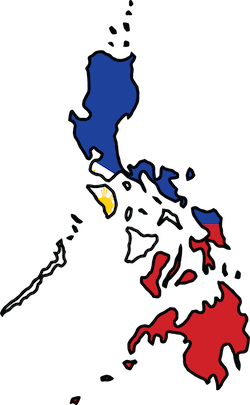English Reading Practice
The
Philippines
The Philippines is a country in Southeast Asia. It is a very large country that is made up of many islands. There are approximately 7000 different islands that make up the Philippines. "Approximately" means about or almost and is used for numbers and amounts.

People in who live in the Philippines are called Filipino. They speak Filipino and English.
Like many countries, the Philippines has a very interesting history. Different ethnic groups have lived on the various islands of the Philippines for thousands of years. An "ethnic group" is a group of people who share the same culture, language, and traditions.
In the 1500s, explorers from Spain sailed to the Philippines. These explorers settled the Philippines as a Spanish colony (territory). "Settled" means that they started to live there. The Spanish ruled the Philippines for over 300 years.

In the 1900s, the Philippines became an independent nation. This meant that they could form their own government. Today, the Philippines continues to be an independent nation.
Since the Spanish governed the Philippines for so long, the culture of the Philippines was heavily influenced by Spain and Spanish culture. Despite this, the Filipino people maintained their own culture. "Maintained" means kept.
One of the many ways that Filipino culture and traditions live on is through folk literature and mythology.
Folk Literature and Mythology
"Folk" means people from a particular country who have a certain way of life.When you talk about "folk literature and mythology," you are talking about the stories and songs that people tell to each other to remind them of their history or beliefs.
Many times, folk literature and mythology are not written down, but are passed on orally. "Orally" means through talking or singing. This is true with folk stories in the Philippines.
Folk literature in the Philippines tells a couple different kinds of stories. The most common of these are stories about the ancient gods of the Philippines.
These stories are called myths or mythology. Many of these myths are stories about how the Philippines came to be. These are called creation stories.
They tell about how the islands were formed (made), how the people were created, and how the plants and animals came to live on the island. Other myths talk about creatures that live in the forests or in the ground such as fairies (little people who fly) or ghosts.
When stories are passed on orally, they are constantly changing. Once they are written down, the stories do not change. Because the stories in the Philippines are oral, they change and have been influenced by other cultures as those cultures influenced life in the Philippines.
Filipino folk literature has been influenced by the Spanish culture as well as by the Indian culture, Malaysian culture, and the various ethnic cultures that live on the many islands that make up the Philippines.
While many modern-day Filipinos do not completely believe in the myths and stories that are told, they still have a great respect for them. These stories represent important elements of Filipino culture and traditions that modern-day Filipinos do not want to lose.
And now, practice:
The Philippines - Exercises
Vocabulary Questions
1. What does "approximately" mean?a) about
b) exactly
c) equal to
d) different from
b) exactly
c) equal to
d) different from
2. What does "settled" mean?
a) visited
b) stayed
c) left
d) ignored
b) stayed
c) left
d) ignored
3. What does "maintained" mean?
a) left behind
b) started new
a) kept the same
b) changed
b) started new
a) kept the same
b) changed
Grammar Questions
1. The Philippines is _________ country in Southeast Asia.a) a
b) the
c) an
d) that
b) the
c) an
d) that
2. The Philippines _________ a very interesting history
a) has
b) had
c) had had
d) will have
b) had
c) had had
d) will have
3. The Spanish ruled the Philippines _________ over 300 years.he world.
a) on
b) at
c) in
d) for
b) at
c) in
d) for
Comprehension Questions
1. Approximately how many island make up the Philippines?_______________________________________________________________
2. How are Filipino folk literature and myths passed on?
_______________________________________________________________
3. What kinds of stories are most of the Filipino myths?
_______________________________________________________________
Get Updates, Special Offers, and English Resources
Download your FREE GIFT (the first two chapters of
English Short Stories Book and Workbook)
as soon as you join!

By submitting your email, you consent to receiving updates and newsletters from us and to the sharing of your personal data with third parties for the purposes of sending you communications. We will not spam you. You can unsubscribe at any time. For more information, please see our privacy policy.




